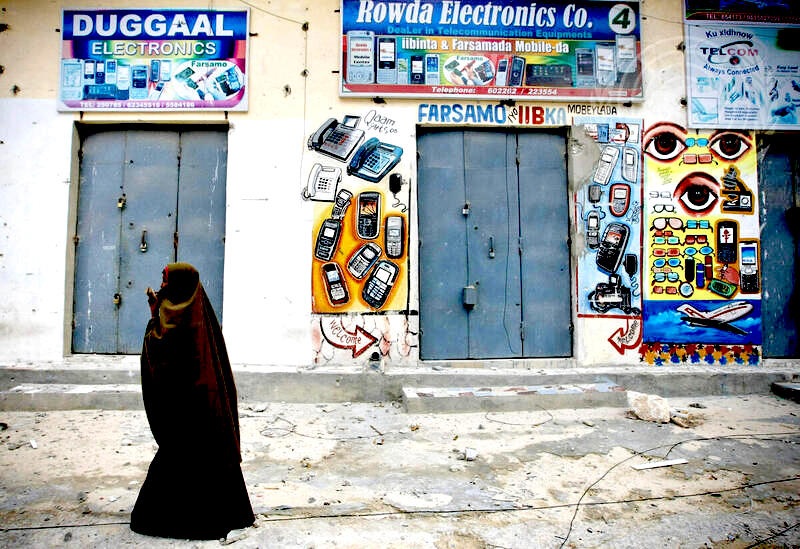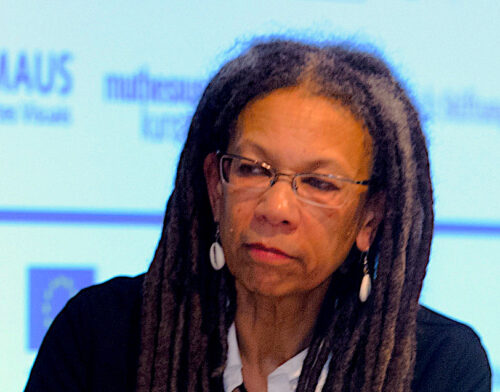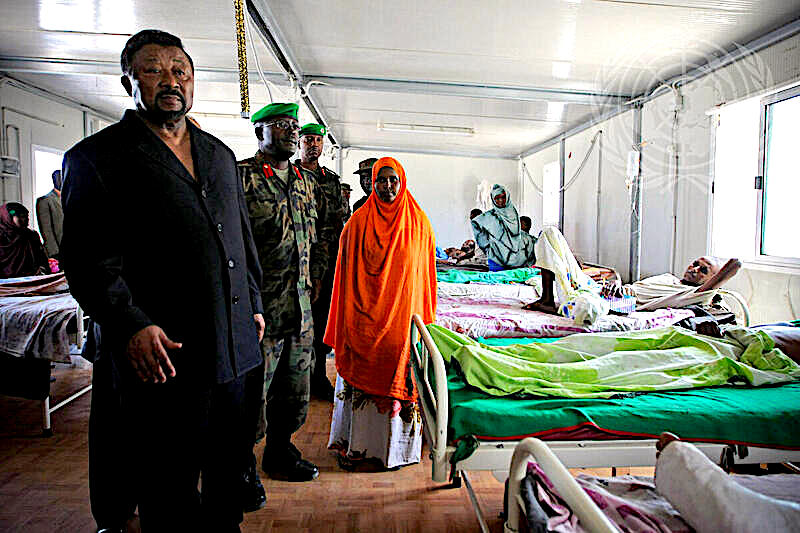African states are more involved in the war on terror than we may think, writes Samar Al-Bulushi.

March 2012: Four suspected members of Al Shabaab walk on the grounds of Mogadishu Stadium in the capital of Somalia. They were captured during a joint operation by AMISOM and Somali security services and found in possession of a rocket-propelled grenade, two sub-machine guns and 84 rounds of ammunition. (UN Photo)
By Samar Al-Bulushi
Africa is a Country
 In late January, reports circulated on social media about a suspected U.S. drone strike in southern Somalia, in the Al-Shabaab controlled Ma’moodow town in Bakool province. Debate quickly ensued on Twitter about whether the newly installed Biden administration was responsible for this strike, which was reported to have occurred at 10 p.m. local time on Jan 29.
In late January, reports circulated on social media about a suspected U.S. drone strike in southern Somalia, in the Al-Shabaab controlled Ma’moodow town in Bakool province. Debate quickly ensued on Twitter about whether the newly installed Biden administration was responsible for this strike, which was reported to have occurred at 10 p.m. local time on Jan 29.
Southern Somalia has been the target of an unprecedented escalation of U.S. drone strikes in the last several years, with approximately 900 to 1,000 people killed between 2016 and 2019. According to the nonprofit group Airwars, which monitors and assesses civilian harm from airpower-dominated international military actions, “it was under the Obama administration that a significant U.S. drone and airstrike campaign began,” coupled with the deployment of Special Operations forces inside the country. Soon after Donald Trump took office in 2017, he signed a directive designating parts of Somalia “areas of active hostilities.”
While the U.S. never formally declared war in Somalia, Trump effectively instituted war-zone targeting rules by expanding the discretionary authority of the military to conduct airstrikes and raids. Thus the debate over the Jan. 29 strike largely hinged on the question of whether President Joe Biden was upholding Trump’s “flexible” approach to drone warfare, which sanctioned more airstrikes in Somalia in the first seven months of 2020 than were carried out during the administrations of George W. Bush and Barack Obama, combined.
In the days following the Jan. 29 strike, the U.S. Military’s Africa Command (AFRICOM) denied responsibility, claiming that the last U.S. military action in Somalia occurred on Jan. 19, the last full day of the Trump presidency. Responding to an inquiry from Airwars, AFRICOM’s public affairs team announced:
“We are aware of the reporting. U.S. Africa Command was not involved in the Jan. 29 action referenced below. U.S. Africa Command last strike was conducted on Jan. 19. Our policy of acknowledging all airstrikes by either press release or response to query has not changed.”
In early March, The New York Times reported that the Biden administration had in fact imposed temporary limits on the Trump-era directives, thereby constraining drone strikes outside of “conventional battlefield zones.”
In practice, this means that the U.S. military and the CIA now require White House permission to pursue terror suspects in places like Somalia and Yemen where the U.S. is not “officially” at war. This does not necessarily reflect a permanent change in policy, but rather a stopgap measure while the Biden administration develops “its own policy and procedures for counterterrorism kill-or-capture operations outside war zones.”

Aug. 9, 2011: A woman outside closed businesses in an area of central Mogadishu that had been an Al Shabaab stronghold until just a few days earlier. (UN Photo)
If we take AFRICOM at its word about Jan. 29, this provokes the question of who was behind that particular strike. Following AFRICOM’s denial of responsibility, analysts at Airwars concluded that the strike was likely carried out by forces from the African Union peacekeeping mission in Somali (AMISOM) or by Ethiopian troops, as it occurred soon after Al-Shabaab fighters had ambushed a contingent of Ethiopian troops in the area. If indeed the military of an African state is responsible for the bombing, what does this mean for our analysis of the security assemblages that sustain the U.S. ’s war-making apparatus in Africa?
Thanks to the work of scholars, activists, and investigative journalists, we have a growing understanding of what AFRICOM operations look like in practice. Maps of logistics hubs, forward operating sites, cooperative security locations, and contingency locations — from Mali and Niger to Kenya and Djibouti — capture the infrastructures that facilitate militarism and war on a global scale. Yet what the events of Jan. 29 suggest is that AFRICOM is situated within, and often reliant upon, less scrutinized war-making infrastructures that, like those of the United States, claim to operate in the name of security.
Geopolitical Projects
A careful examination of the geographies of the U.S. so-called war on terror in East Africa points not to one unified structure in the form of AFRICOM, but to multiple, interconnected geopolitical projects.

Ruth Wilson Gilmore in 2012. (Heinrich-Boll-Stiftung, Flickr, CC BY-SA 2.0)
Inspired by the abolitionist thought of Ruth Wilson Gilmore, who cautions activists against focusing exclusively on any one site of violent exception like a prison, I am interested in the relational geographies that sustain the imperial war-making infrastructure in Africa today.
Just as the modern prison is “a central but by no means singularly defining institution of carceral geography,” AFRICOM is a fundamental but by no means singularly defining instrument of war-making in Africa today.
Since the U.S. military’s embarrassing exit from Somalia in 1993, the U.S. has shifted from a boots-on-the ground approach to imperial warfare, instead relying on African militaries, private contractors, clandestine ground operations, and drone strikes.
To singularly focus on AFRICOM’s drone warfare is therefore to miss the wider matrix of militarized violence that is at work. As Madiha Tahir, who studies digital and drone warfare at Columbia University, reminds us, attack drones are only the most visible element of what she refers to as “distributed empire” — differentially distributed opaque networks of technologies and actors that augment the reach of the war on terror to govern more bodies and spaces.
This dispersal of power requires careful consideration of the racialized labor that sustains war-making in Somalia, and of the geographical implications of this labor. The vast array of actors involved in the war against Al-Shabaab has generated political and economic entanglements that extend well beyond the territory of Somalia itself.
Ethiopia was the first African military to intervene in Somalia in December 2006, sending thousands of troops across the border, but it did not do so alone. Ethiopia’s effort was backed by U.S. aerial reconnaissance and satellite surveillance, signaling the entanglement of at least two geopolitical projects.
While the U.S. was focused on threats from actors with alleged ties to Al-Qaeda, Ethiopia had its own concerns about irredentism and the potential for its then-rival Eritrea to fund Somali militants that would infiltrate and destabilize Ethiopia. As Ethiopian troops drove Somali militant leaders into exile, more violent factions emerged in their place. In short, the 2006 invasion planted the seeds for the growth of what is now known as Al-Shabaab.
African Union Mission in Somalia

Nov. 18, 2011: A Burundian soldier with the AMISOM in a frontline position in territory recently captured from insurgents in northern fringes of Mogadishu. (UN Photo)
The United Nations soon authorized an African Union peacekeeping operation (AMISOM) to “stabilize” Somalia. What began as a small deployment of 1,650 peacekeepers in 2007 gradually transformed into a number that exceeded 22,000 by 2014.
The African Union has emerged as a key subcontractor of migrant military labor in Somalia: troops from Burundi, Djibouti, Ethiopia, Kenya, and Uganda deployed to fight Al-Shabaab are paid significantly higher salaries than they receive back home, and their governments obtain generous military aid packages from the U.S., U.K., and increasingly, the European Union, in the name of “security.”
But because these are African troops rather than American ones, we hear little of lives lost, or of salaries not paid. The rhetoric of “peacekeeping” makes AMISOM seem something other than what it is in practice—a state-sanctioned, transnational apparatus of violent labor that exploits group-differentiated vulnerability to premature death. (This is also how Gilmore defines racism.)

Aug. 20, 2011: Jean Ping (left), chairperson of the African Union Commission, visits wounded Transitional Federal Government, or TFG, soldiers in Mogadishu. (UN Photo)
Meanwhile, Somali analyst Abukar Arman uses the term “predatory capitalism” to describe the hidden economic deals that accompany the so-called stabilization effort, such as “capacity-building” programs for the Somali security apparatus that serve as a cover for oil and gas companies to obtain exploration and drilling rights. Kenya is an important example of a “partner” state that has now become imbricated in this economy of war.
Following the Kenya Defense Forces (KDF) invasion of Somalia in October 2011, the African Union’s readiness to incorporate Kenyan troops into AMISOM was a strategic victory for Kenya, as it provided a veneer of legitimacy for maintaining what has amounted to a decade-long military occupation of southern Somalia. Through carefully constructed discourses of threat that build on colonial-era mappings of alterity in relation to Somalis, the Kenyan political elite have worked to divert attention away from internal troubles and from the economic interests that have shaped its involvement in Somalia.
From collusion with Al-Shabaab in the illicit cross-border trade in sugar and charcoal, to pursuing a strategic foothold in offshore oil fields, Kenya is sufficiently ensnared in the business of war that, as Horace Campbell observes, “it is not in the interest of those involved in this business to have peace.”
What began as purportedly targeted interventions spawned increasingly broader projects that expanded across multiple geographies. In the early stages of AMISOM troop deployment, for example, one-third of Mogadishu’s population abandoned the city due to the violence caused by confrontations between the mission and Al-Shabaab forces, with many seeking refuge in Kenya. While the mission’s initial rules of engagement permitted the use of force only when necessary, it gradually assumed an offensive role, engaging in counterinsurgency and counterterror operations.
Rather than weaken Al-Shabaab, the UN Monitoring Group on Somalia observed that offensive military operations exacerbated insecurity. According to the UN, the dislodgment of Al-Shabaab from major urban centers “has prompted its further spread into the broader Horn of Africa region” and resulted in repeated displacements of people from their homes.
Meanwhile, targeted operations against individuals with suspected ties to Al-Shabaab are unfolding not only in Somalia itself, but equally in neighboring countries like Kenya, where U.S.-trained Kenyan police employ military tactics of tracking and targeting potential suspects, contributing to what one Kenyan rights group referred to as an “epidemic” of extrajudicial killings and disappearances.

Aug. 18, 2011: Civilians in northern Mogadishu, near the old cigarette and match factory where Burundian soldiers with AMISOM established a new position after a retreat by Al Shabaab. (UN Photo)
Finally, the fact that some of AMISOM’s troop-contributing states have conducted their own aerial assaults against Al-Shabaab in Somalia demands further attention. A December 2017 United Nations report, for example, alleged that unauthorized Kenyan airstrikes had contributed to at least 40 civilian deaths in a 22-month period between 2015 and 2017.
In May 2020, senior military officials in the Somali National Army accused the Kenyan military of indiscriminately bombing pastoralists in the Gedo region, where the KDF reportedly conducted over 50 airstrikes in a two week period. And in January 2021, one week prior to the Jan. 29 strike that Airwars ascribed to Ethiopia, Uganda employed its own fleet of helicopter gunships to launch a simultaneous ground and air assault in southern Somalia, contributing to the deaths—according to the Ugandan military—of 189 people, allegedly all Al-Shabaab fighters.
While each of the governments in question are formally allies of the U.S., their actions are not reducible to U.S. directives. War-making in Somalia relies on contingent and fluid alliances that evolve over time, as each set of actors evaluates and reevaluates their interests.
The ability of Ethiopia, Kenya, and Uganda to maintain their own war-making projects requires the active or tacit collaboration of various actors at the national level, including politicians who sanction the purchase of military hardware, political and business elite who glorify militarized masculinities and femininities, media houses that censor the brutalities of war, logistics companies that facilitate the movement of supplies, and the troops themselves, whose morale and faith in their mission must be sustained.
As the Biden administration seeks to restore the image of the United States abroad, it is possible that AFRICOM will gradually assume a backseat role in counter-terror operations in Somalia. Officially, at least, U.S. troops have been withdrawn and repositioned in Kenya and Djibouti, while African troops remain on the ground in Somalia. Relying more heavily on its partners in the region would enable the U.S. to offset the public scrutiny and liability that comes with its own direct involvement.
But if the focus is exclusively on the U.S., then one can succumb to its tactics of invisibility and invincibility, and one fails to reckon with the reality that the East African warscape is a terrain shaped by interconnected modes of power. The necessary struggle to abolish AFRICOM requires a recognition of the entanglement in and reliance upon other war-making assemblages.
Samar Al-Bulushi is a contributing editor of Africa Is a Country and on the faculty of University of California, Irvine.
This article is from Africa is a Country and is republished under a creative commons license.
The views expressed are solely those of the authors and may or may not reflect those of Consortium News.



Congratulations to Samar Al-Bulushi who brilliantly walks the reader through the complex web of western militarism in Arica and uncovers the role of regional allies who have a heavy hand in the continent’s wars.
I hope, Selab, that this article might get the attention of those who would appreciate the excellent, in depth perspective Samar Al-Bulushi provides us.
There is really no reasonable excuse that U$ians may claim in refusing to examine what is done in their names, either directly or through proxies over the last seventy-odd years, and the current U$ presence in Africa, which continent seems a region of the world that far too many have no interest in learning about or concerning themselves with.
Too often, “third world” nations and societies are simply dismissed as backward or not worthy of the interest of those who live in the nation which prides itself on being Number One! in the world.
I have actually heard it said that it is not wise for U$ians to know what the U$ military is doing in Africa, “because, if we know, then so will the enemy.”
The hubris and arrogance reflected in that attitude speaks volumes.
It reflects notions that may only be understood as indifference, which ranges from the casual to the depraved.
Dismissed as “collateral damage”, euphemistic evasion characterizes such meager media “coverage” as the average U$ian encounters, ensuring that such violence, call it organized mayhem, never sparks debate or popular push-back.
I suspect few will comment on this article because it describes just one more obscure little war in what is called a sh!t-hole country that 99.9% of Americans know nothing about, mostly because our “free press” has nothing to say about these conflicts, none of which threaten America or its true national interests in the slightest. Who reaps the benefits of these mass killings is the $64 question that begs an answer from no hard-working, tax-paying American citizen with medical bills, kids to feed and mortgages to pay. Much of the time the military hardware, the mercenaries, their recruitment, training, payroll and operations are probably funded for no reason other than to impede the Chinese from potentially developing relations with these nations and investing in the local resources. Freedom and democracy are the least likely objective. Some times it seems that the goal of those running Washington is to corrupt as much of the planet to the theory and practice of gangsterism as is possible.
Superb and totally accurate comment, Realist, in every way.
Media enforced ignorance concerning parts of the world which most U$ians know nothing about, being treated to U$ian “Full Spectrum Dominance” that U$ians not only know nothing about, but also care nothing about, it being sufficient that the “exceptional” and “indispensable” nation, their nation, is making certain that country “X” can never pose a threat to the Merkin Homeland.
That the whole business (from media to munitions) is immensely profitable for a precious few is simply an unintended and unexpected side benefit.
“The beauty of our weapons” and all that.
You and I, Realist, might be disgusted and appalled, and often might discover, when we try to encourage others to look deeper into “things”, that everyone is “too busy” to take such a gander and, if we persist in such encouragement, that our efforts are not only not appreciated but absolutely unwelcome.
Asking questions about, encouraging deeper understanding around, and initiating discussion focused on U$ian aggressions, threats, and military “exercises” is, if not forbidden, terribly uncomfortable for many U$ians.
But then, when empires crumble and civil society collapses, the already comfortable and complacent would rather not notice, while the majority, already hard-pressed economically and socially, have largely been convinced that they can do nothing about much of anything, anyway.
Frankly, by now, it is painfully obvious to a significant number of U$ians that the U$ is flailing and failing, that it has neither moral authority nor human legitimacy.
Corruption rules.
Power in the U$ need not much fear the many, as it has never faced a social upheaval sufficient to really shake the sacred elite.
Yet U$ power, at home, need not, thus far, beat down the streets, slow starvation and lack of shelter will suffice, as the remnants of the middle class and the meritorious managerial class are more than pleased to believe that the suffering is simply the result of lazy personal failure.
Just as “bad” nations deserve to be disciplined and taught “good behavior”, local “losers” deserve austerity and moral instruction.